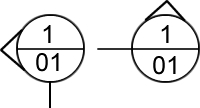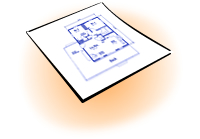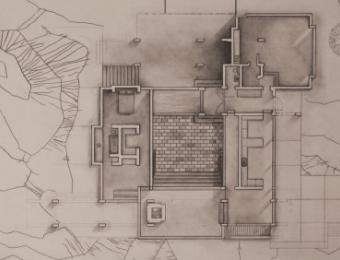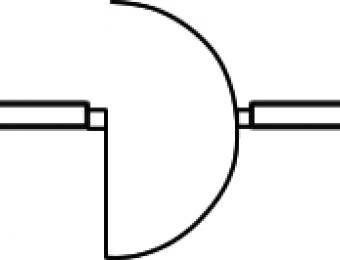If you’re getting a house built, a floor plan is probably the most detailed and important part of the drafting process - and it's essential to understand how the inside of the house will be laid out.
What are floor plans?
In a nutshell, the floor plan is two-dimensional plan of how the house will look from the top down. Floor plans are a kind of cross-section, showing the layout of the house from a perspective roughly three or four feet (about a metre) above the floor.
If the house has more than one storey, your floor plan will feature clearly labelled diagrams showing each separate storey.
What’s on a floor plan?
There’s quite a lot of detail on a floor plan, and while most people will be able to make basic sense of it all at a glance, there’s still plenty to decipher in if you’re not familiar with how things are shown.
Below is a quick explanation of the more important features on a floor plan and how they’re represented:
- Walls – the walls are arguably the most important part of the floorplan, because they effectively determine the size and shape of the house, and how rooms are laid out. The exterior profile of the house is normally outlined with a thick, dark line. Exterior walls are represented on the floor plan as thicker than interior walls – often to the scale of the actual intended width.
- Doors – The doors in the house are represented on a floor plan indicating not only where they’re installed, but also in which direction they’ll move and on what side the handles will be (i.e. the ‘handing’ of the door). Sliding doors are often represented either by depicting the individual panels, or simply using a narrow line, sometimes with an arrow at one end.
- Floors – Floors on a floor plan are often textured with shading or light coloured lines to indicate the use of different floor surfaces or coverings.
- Stairs – To keep things clear, stairs feature an arrow to show which way’s up. It’s important that the details for stairs are correct on floor plans, and they’re likely to feature callouts showing specific sizes, how many risers will be used for the stair and the exact clearances that are required. Stair details are also likely to include specifics about handrails and balustrades, which are a very important safety feature in Australia.
- Windows – The windows on floor plans are illustrated using unfilled blocks in areas along walls. If the windows open outwards, the arc they travel in may also be drawn in as it is for doors. Because there are so many different options for windows, these often feature a ‘callout’ on the diagram showing detailed specifics about what they’re intended to be.
- Fittings and fixtures – Standard fittings and fixtures are normally diagrammed into floor plans. This includes things like kitchen cabinetry, bathtubs, toilets, showerheads, ovens, sinks (with drain boards) hot water units, dishwashers, bidets and the like. There are ‘standard’ symbols for most of these elements, and where possible they should be drawn to scale.Where dotted lines are used to depict things like kitchen cabinets, it means these items are mounted overhead.
Furnishings like bedding, televisions, sofas and dining tables are also included on many floor plans to provide a bit of context and scale. Different materials are normally specified using different shading conventions and abbreviations, although these aren’t always specified on earlier drawings.
[caption caption="The title block explains what the plan is for." align="right"]
[/caption]
The title block
A floor plan should also contain what’s called a ‘title block’. This normally sits in the bottom right hand corner of the plan (or sometimes at the top right corner), and contains administrative details including:
- the name and contact details of your designer, architect or builder
- the title or name of the drawing
- the drawing (or revision) number
- signatures, initials, dates etc.
The title block may also show the total floor area in square metres (m2), and possibly the areas of different parts of the house. This is useful because most builders quote for work by the square metre. Builders normally only look at the total floor area, and often won’t differentiate in their quotes for things like verandahs and patios, which are generally cheaper to construct than other parts of the house.
What do the symbols and figures mean?
For the most part, a floor plan’s pretty easily understood at first glance, but you’ll notice that there’s quite a bit of cryptic detail in it and that a great deal of care and attention’s gone into making sure everything’s done just right.
The types and thicknesses of the lines, the directions of the arrows, little abbreviations, symbols and markings all hold vital significance, and are included to ensure that the builder understands exactly what’s required, and where.
In theory, the floor plan should be drawn to comply with what’s laid out in the Australian Standard AS1100 (Part 301: Architectural Drawing) however there are likely to be slight differences in the way some things are depicted on floor plans, depending on what software’s used to draw the plans.
[caption caption="The compass on a floor plan tells you which way is north." align="right"]
[/caption]
Floor plan orientation and scale
Floor plans should feature a north point to show how the house is oriented – the direction it faces makes a big difference to heating, cooling and lighting the house. This could be drawn in any one of a number of ways, but it should be pretty obvious when you see it.
Where possible, other plans (e.g. site plans, drainage plans etc.) should also be oriented in the same way to help prevent any kind of unnecessary confusion.
[caption caption="Scales indicate relative sizes and distances." align="right"]![]()
[/caption]
Floor plans normally feature a written ratio (e.g. Scale 1:100) to demonstrate scale, as well as a block or granulated scale, which helps give a visual indication of sizes and distances. Measurements are almost always provided in millimetres – the exception being that metres are sometimes used to give a general idea of room sizes.
[caption caption="References like these ones tell the reader where to find more detail about a particular part of the plan." align="right"]
[/caption]
Cross references and extra detail
Floor plans are designed to show the house from a particular angle, and to a specific scale and level of detail. While they’re very useful, other diagrams are obviously necessary to provide more detail about how certain part of the house need to be laid out or constructed.
Cross reference symbols are used to show which parts of the floor plan correspond to other drawings. The top number on these references refers to the drawing, detail or sequence number in question, and the bottom number tells which sheet number for that drawing.
Check our table of abbreviations and symbols for further information on how to interpret these symbols.





